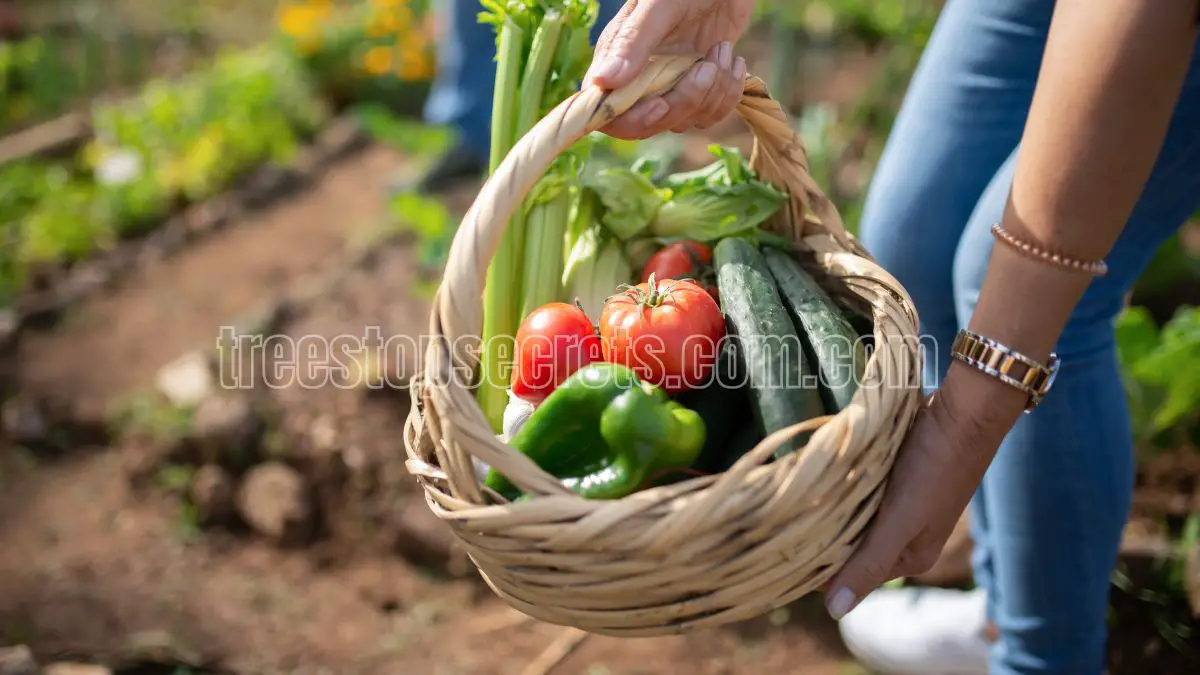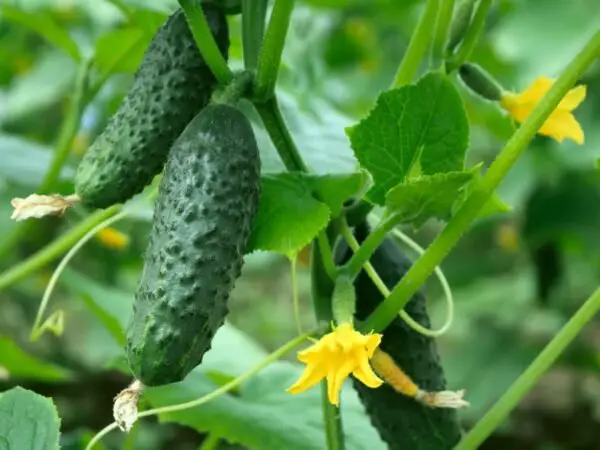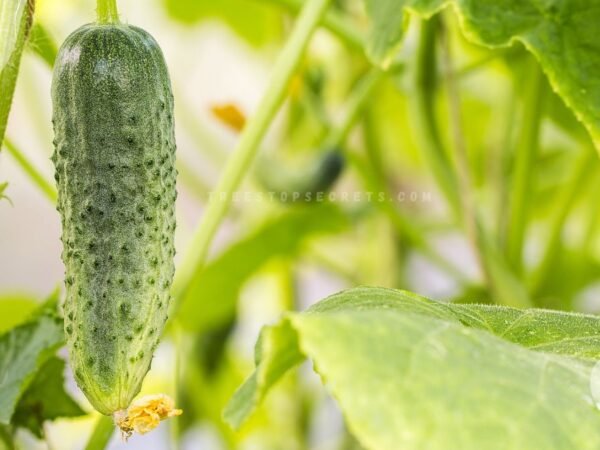Cucumber is botanically a fruit. Most people would call it a vegetable because of its vegetable-y taste and the fact that it’s often used in salads. From a scientific standpoint, it’s considered a fruit. Cucumbers grow from the flowering part of the plant and have seeds, two defining features of fruits.
If you grow cucumbers in your backyard garden, you’re in for a satisfying experience, indeed. They love the warm weather and require very little maintenance. Their cooling crispness is a crunchy addition to so many recipes.
Knowing that cucumbers are fruits only makes you a better cook. It unlocks exciting new ways to eat, use, and appreciate this incredible plant. Read on to discover all that cucumbers have to offer and the important role they play in our diets.
Key Takeaways
- Did you know cucumbers are fruits too? They have edible seeds and grow from the flowering plant’s ovary. This botanical distinction has a concrete difference in our gardening and agricultural practices.
- Although cucumbers are botanically fruits, they are considered vegetables due to their flavor profile and culinary use. Consider the way they liven up salads and become the base of the best pickles! This makes the case for understanding the difference between botanical versus culinary classifications.
- More than just a healthy addition to a salad, cucumbers have some pretty impressive nutritional benefits. They’re very low in calories and mostly water, which means they’re awesome for hydration and healthy eating.
- As a result, cucumbers are an important cultural and agricultural component in dozens of countries. From crisp salads to zesty condiments, their delicious ability to transform any dish is staggering.
- Find out how language and economic interests have shaped public perceptions over the years.
- One of the most common misconceptions about cucumbers is believing that they are only vegetables. It’s important to know these differences, both their botanical and culinary definitions, to choose a healthy diet.
What is the Botanical Definition of Fruits?
To know what a fruit is, one must start with the botanical definition of a fruit. A fruit is, botanically speaking, the mature ovary of a flowering plant, enclosing seeds. This role is key in plant reproduction.
It helps with the dispersal of seeds, allowing plants to permeate their ecosystems and flourish in a variety of conditions. Fruits form from the species fertilized ovary of blooms, serving an essential role in the plant reproductive process.
1. Define fruits in botanical terms
Based on botanical definitions, fruits may be grouped into the following categories according to their anatomy. Simple fruits, such as cherries, form from a single ovary.
In comparison, aggregate fruits—which include raspberries—are derived from a single flower containing many ovaries. Compound fruits, such as the pineapple, develop from inflorescences with many flowers.
Botanically, fruits can be fleshy, like peaches, or dry, like nuts. In botanical language, it is very important to find the distinction between true fruits and accessory fruits. True fruits grow solely from the ovary, but accessory fruits include non-ovarian floral structures.
2. Identify key plant structures of fruits
Important structures of fruits are the pericarp, seeds, and placenta. The pericarp consists of three layers: the exocarp (outer skin), mesocarp (fleshy middle), and endocarp (inner layer).
These fleshy layers in fruits protect and nourish developing seeds. They are used in maintaining prolonged development of the seeds contained inside the fruit.
3. Explain the reproductive role of fruits
The role of fruits is to protect and nourish seeds while they mature. They assist with seed dispersal as well, using wind, water, and animals to carry seeds away.
This process is fundamental for fostering genetic diversity within plant species, allowing them to survive and adapt to new conditions in a rapidly changing world.
Are Cucumbers Fruits or Vegetables?
Cucumbers certainly ignite an intriguing discussion among botanists and chefs alike. Botanically speaking, cucumbers are considered fruits because they contain the seeds of the plant, placed in the species Cucumis sativus. This classification is based on their edible anatomy.
Cucumbers develop from the flowering portion of the plant and have seeds inside, so they very much align with the scientific definition of a fruit. Whether you’re tending to a garden or a field, knowing this classification can help you strategically plant and harvest crops.
In the practical world of the kitchen, cucumbers occupy a grey area between fruits and vegetables. Most everyone considers them to be a vegetable due to their deliciously savory taste. They’re a staple in all sorts of salads, pickles and even smoothies.
The Supreme Court once ruled on whether cucumbers were fruits or vegetables for tax purposes, underscoring the confusion surrounding their classification. This culinary viewpoint tends to focus on flavor, because cucumbers lack the sweetness usually associated with fruits.
Perceptions play a large role in how cucumbers are seen around the world. In other parts of the world, culinary traditions determine how they are used, resulting in different classifications.
In most Asian dishes, cucumbers play the lead role in chilled, crisp salads. In Western cuisine, they usually appear pickled, reinforcing the idea that they are vegetables. Because cucumbers are so full of water, they’re 95% hydrating.
They make sure the average American eats some 8 pounds of this delicious vegetable every year.
Nutritional Aspects of Cucumbers
Sliced cucumbers, especially the slicing cucumber variety, add a refreshing crunch to salads and sandwiches or can be enjoyed on their own for a healthy snack. Their high water content, about 96%, makes them an ideal food for promoting hydration, crucial for metabolic health.
1. Present Nutritional Facts About Cucumbers
- Water: 96%
- Vitamins: Particularly rich in vitamin K
- Minerals: Good amounts of potassium and magnesium
A ½ cup serving of sliced, raw cucumber has only 8 calories, including 2 grams of carbohydrate and no fat. Their low-calorie nature serves to position cucumbers as an ideal choice for those seeking to maintain or lose weight.
Their hydrating properties help maintain proper bodily functions and they’re great for keeping skin looking youthful.
2. Explore Health Benefits Associated with Cucumbers
Due to their high water content and vitamin K, cucumbers are instrumental in increasing hydration levels and boosting skin health. Their low-calorie count—about 19 calories per serving—makes them effective tools for healthier weight management.
Cucumbers are a great source of antioxidants, including a unique compound called cucurbitacins, that can help fight inflammation and boost your overall health.
3. Discuss Sugar-Acid Balance in Cucumbers
Additionally, cucumbers’ natural sugar content helps to balance out their mild flavor with a subtle sweetness, while their acidity provides a pleasantly tart zing. That sugar-acid balance makes them such a great addition to salads and other preparations.
They become instant complements to just about any culinary masterpiece.
Culinary Uses of Cucumbers
From subs to salads, burgers to sushi, cucumbers, including slicing cucumbers and pickling cucumbers, elevate culinary experiences around the globe. From cooling salads to tangy relishes, these veggies take center stage in culinary traditions that embrace their delightful crunch and subtle taste.
1. Examine global culinary practices with cucumbers
Cucumbers find their way into numerous international dishes, such as:
- Tzatziki from Greece
- Sushi rolls in Japan
- Raita in India
- Gaspacho in Spain
Regardless of which culture you look to, cucumbers are made in specific, distinct ways. In Mediterranean cuisine, they are a staple ingredient in salads, where they are frequently diced and combined with yogurt and herbs.
In Asia, they could be pickled or eaten raw with soy sauce. Their thirst-quenching quality makes cucumbers a perfect addition to summer meals and drinks, helping you stay cool as a cucumber.
2. Highlight common cucumber recipes
Easy cucumber recipes abound, including:
- Cucumber salad with feta and olives
- Creamy cucumber dip with yogurt
- Cucumber sandwiches for tea time
Cucumbers can be enjoyed raw or gently cooked, maintaining their crunch. Pair them with yogurt, fresh herbs like dill or mint, or spices such as cumin to enhance their flavor.
3. Discuss cucumber varieties, including lemon cucumbers
There are 5 main culinary types of cucumbers. You’ll find slicing cucumbers, pickling cucumbers, and the wonderfully funky round and yellow lemon cucumbers.
Lemon cucumbers bring a milder, fresher, and slightly sweeter flavor than regular cucumbers. It’s important to pick the right variety because the right cucumber can take your dish’s flavor and texture to the next level.
Historical Perspectives on Cucumber Classification
Cucumbers have such a deep and interesting history that it is indicative of the changing attitudes toward their classification. Historically, various societies have categorized cucumbers as fruits and vegetables at varying times based on cultural needs and domestic practices of agriculture. Even in the earliest of civilizations, Egypt and Greece, humans praised cucumbers for their cooling and invigorating character.
They and their many descendants frequently grouped cucumbers with fruits in their culinary practices. In medieval Europe, cucumbers were considered vegetables, mostly eaten in savory recipes. Ancient authorities like Pliny the Elder recorded these hierarchies, influencing perceptions of cucumbers for generations.
These simple words offer powerful insight into how language can shape, inform, and complicate cucumber classification. Adding to the confusion, regional differences in terminology can shape public perception. For example, in some languages the word for cucumber is very similar to that of fruits, affecting cultural practices and cuisine.
In this way, misclassification becomes a predictable result of these linguistic discrepancies, leaving consumers baffled. In the United States, cucumbers are most commonly considered kitchen vegetables. Botanically speaking, they’re technically fruits, which only complicates the identity of this popular garden favorite.
Misconceptions warning us that cucumbers are solely vegetables still linger, warping our culinary imaginations. Don’t let anyone fool you into forgetting how versatile they are in salads and desserts! Having some context behind the botanical versus culinary classification can help us all make productive dietary decisions.
With this understanding we can all celebrate cucumbers and their many tasty interpretations. By embracing their double identity, we’ll appreciate their flavor-enhancing super powers and unlock their health-boosting potential.
Conclusion
Cucumbers are especially an outlier in this regard. While they are in fact fruits, they often play the role of a vegetable in our kitchens. Their cool crunchiness and clean flavor really make a salad or sandwich pop! Full of water and vitamins, dip a cucumber in hummus or oil and bring cucumber health to summertime! Plus, they bring a satisfying crunch that tops off literally anything. Slice them up for a healthy snack or toss them into a delicious summer salad! Whether raw or cooked, cucumbers bring great flavor, crunch and nutrition to your plate. So when you grab a cucumber this summer, think about the long history that fruit has taken from production to consumption. Explore the exciting world of cucumbers and start experiencing their benefits today!
Frequently Asked Questions
Is cucumber a fruit or a vegetable?
Botanically speaking, cucumber is classified as a fruit because it develops from the bloom of the cucumber plant and contains seeds, a key trait of fruits in the family cucurbitaceae.
What are the health benefits of cucumbers?
Whether you eat them pickled, marinated, or fresh, cucumbers, a member of the family cucurbitaceae, are low in calories and 96% water. With so many beneficial nutrients—including high levels of hydration, antioxidants, and vitamins—these botanical fruits contribute to beautiful skin and improved digestion.
How should cucumbers be stored?
To maintain the freshness of cucumbers, especially slicing cucumbers and pickling cucumbers, store them in a sealed plastic bag in the refrigerator's crisper drawer for optimum storage.
Can cucumbers be eaten raw?
As a general rule, cucumbers, particularly slicing cucumbers, are more often eaten raw. Their crisp, cool texture makes them a great refreshing addition to salads and savory dishes.
Are cucumbers good for hydration?
Absolutely true indeed. Being composed of nearly 95% water, cucumbers, including slicing cucumbers and pickling cucumbers, are hydrating snacks ideal for warm weather days and post-workout recuperation.
What nutrients are found in cucumbers?
Cucumbers, a member of the cucurbitaceae family, are an excellent source of vitamins K and C, potassium, and magnesium. In addition to being low in calories, these veggies provide crucial nutrients and loads of antioxidants.
How can cucumbers be used in cooking?
Cucumbers, part of the family cucurbitaceae, are refreshing and versatile, perfect in salads, sandwiches, or as pickles. They can be sliced into salads, blended into smoothies, or used as a beautiful garnish for cocktails.
Image Source: Paid image from CANVA




